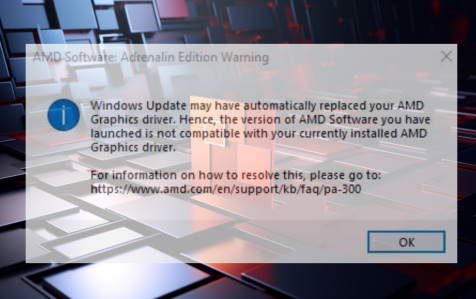This article explores the widespread issue of Windows Update automatically replacing AMD drivers, leading to incompatibility, crashes, and gaming lags. We trace the issue’s detection, the community’s efforts to fix it, its ongoing presence, and related graphics card issues. It further spotlights diverse user experiences and potential solutions, equipping those affected with necessary insights.
Problem Detection and Initial Attempts at Resolution
The first reports of an emerging issue surfaced with users noting anomalies on Windows 11: incompatible drivers were not being displayed, and certain features would not enable, despite no detectable issues with device drivers during scanning or updates. An initial solution surfaced from the community suggesting a change in the registry key, with the expectation that this would resolve the problem. Unfortunately, the problem persisted, even when this registry key was set as recommended. Some users even reported that changing the registry key led to a situation where certain features were managed by the system administrator, leaving the user unable to adjust them.
Continued Attempts at Problem Resolution
Despite facing an unsolved problem, the community did not relent. Users tried various troubleshooting methods, including resetting the PC, removing updates, and making further changes to registry values. All this was done in the hopes of finding a user-friendly solution. A moderator from the community suggested a fix related to the Local Security Authority Subsystem Service (LSASS) and recommended creating a new system restore point, along with the relocation of certain drivers. Some users, however, expressed concerns about potential problems that could arise from renaming, moving, or deleting data from system directories. In the end, the community found itself echoing a persistent request for a fix from Microsoft.
Graphics Card-Related Issues and Suggested Fixes
In parallel to the main issue, users started reporting graphics card-related problems. These stemmed from an automatic Windows update which seemed to replace the AMD graphics drivers. The consequences were grave, causing screens to go black, games to crash, and significant lags. Independent advisors from the community provided two solutions: manually updating the graphics driver through the Device Manager and performing a system restore. While these solutions did help some, others found themselves facing the same issues, even after trying these fixes.
Expert Tip: For smoother PC performance, consider using a PC optimization tool. It handles junk files, incorrect settings, and harmful apps. Make sure it's right for your system, and always check the EULA and Privacy Policy.
Special offer. About Outbyte, uninstall instructions, EULA, Privacy Policy.
Persistence of the AMD Driver Replacement Issue
The problem of Windows automatically replacing AMD drivers seemed to persist, even after numerous attempts to stop this from happening. Users went to great lengths to address this issue, attempting various methods, from using group policy to third-party software to prevent automatic driver updates. Still, for many, these efforts were not fruitful. As a result of the persistent issue, some users even considered switching to other graphics card manufacturers, a move indicating the severity of the problem at hand.
User Experiences and Personal Attempts at Resolution
The ordeal with AMD drivers didn’t go unnoticed, and users voiced their frustrations and experiences. For some, stopping driver updates from the Group Policy menu worked. For others, the GPU disappeared from the task manager, while still being visible in the Device Manager. These users were unable to launch specific software, despite running backups and updating drivers, BIOS, etc. There were suggestions about rolling back the graphics card driver and using tools to uninstall and then reinstall AMD drivers. However, even these solutions did not prove successful for everyone. The negative experiences with Radeon drivers led some users to switch back to NVIDIA graphics cards.
Conclusion
In conclusion, the automatic replacement of AMD drivers by Windows Update remains a persistent and troublesome issue. Despite all the solutions tried and tested by the community, a comprehensive fix remains elusive. Microsoft’s intervention is highly anticipated in the community to rectify this problem. In the meantime, we urge users to continue to share their experiences and potential solutions. This issue’s consequences have driven some users to consider switching to other graphics card manufacturers, underscoring the urgency and seriousness of this ongoing problem.
